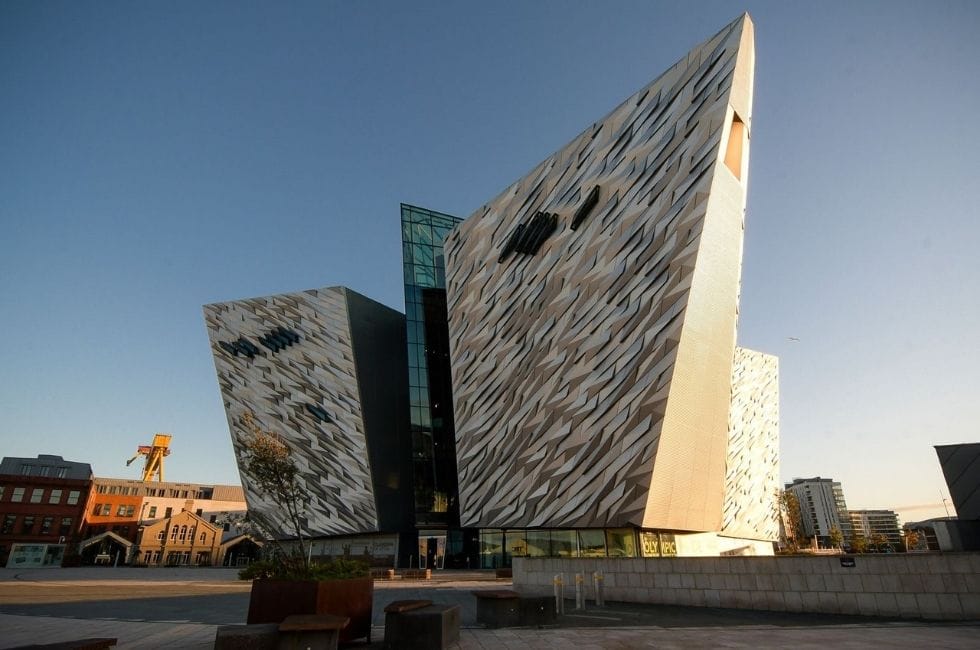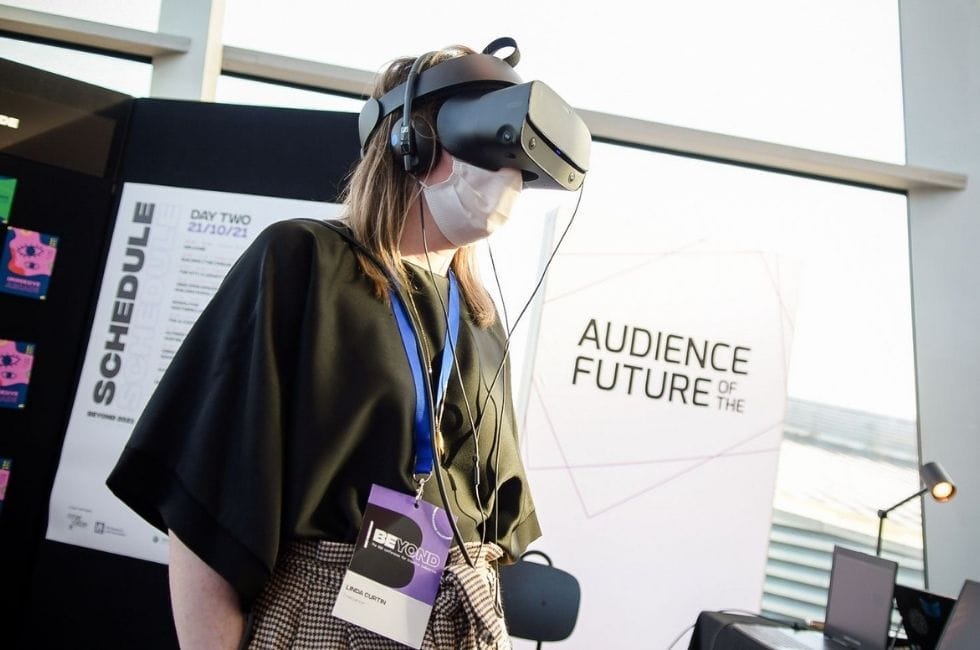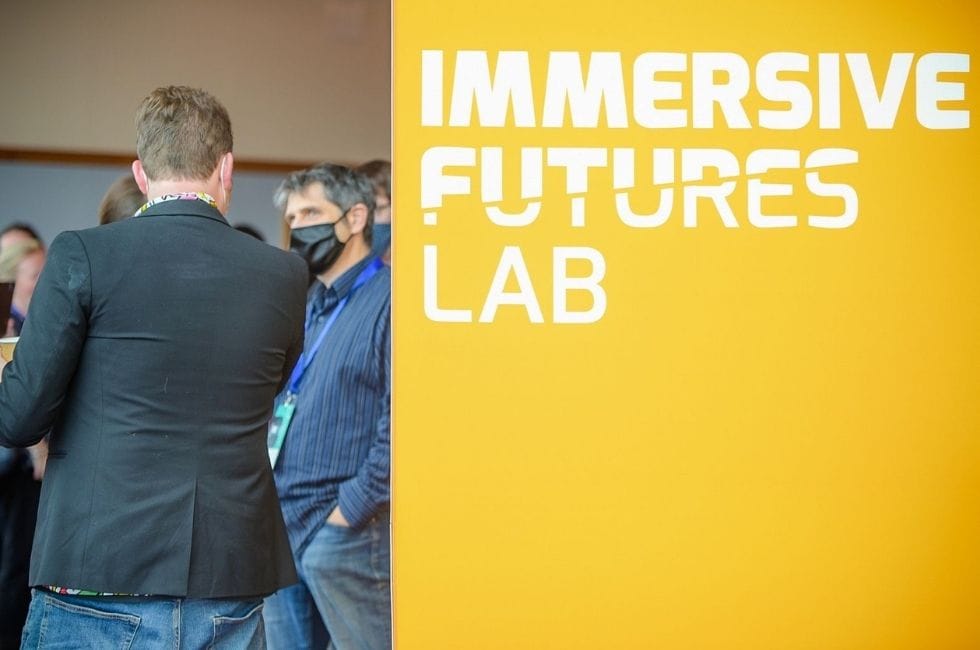“To start with, let me take you back to 1997. That was the year we had the happy news of a brand new birth…”
It was a pleasure and honour to welcome Sir Peter Bazalgette (non-executive Chair of ITV) to the BEYOND 2021 stage, as the opening keynote. Watch the video of his full speech at the conference in Belfast, or read in full below.
Andrew Chitty, UKRI Challenge Director and Chair of Beyond, puts the speech in context:
“Sir Peter Bazalgette’s 2017 report on the Creative Industries was instrumental in framing the Creative Industries as an R&D intensive sector. He also launched the Arts and Humanities Research Council-funded Creative Industries Clusters programme at our very first BEYOND Conference, so we were delighted to welcome him back to Beyond 4 in Belfast. In this typically acute, playful and provocative speech he takes stock of what our current R&D Programmes have achieved but develops from that a vision for the future. At a time when the UK government places ever more emphasis on innovation as a driver for the economy, he challenges the Chancellor to follow the logic of his observation that “there are only a few things you are world class at”, the Creative Industries being one, and to underpin the future growth of the sector with a significant commitment to invest in creative research and innovation.”
Sir Peter Bazalgette @ BEYOND 2021:
“It’s fortunate, and definitely not accidental, that BEYOND is being hosted in Belfast by Future Screen’s this year. Northern Ireland is turning into a trailblazer for the Creative Industries… the only place in the UK where “WINTER IS COMING” is a promise not a threat. More of that later.
And I’ll say unapologetically that I have no slides, videos or other pyrotechnics for you today. One, I can’t compete with the heroic haptics all around us….Two, I can give your eyes a rest for quarter of an hour. So, if you’re sitting comfortably, as they used to say on the steam radio in the last century, I’ll begin.
To start with, let me take you back to 1997. That was the year we had the happy news of a brand new birth…
Roughly the announcement went like this: To Britain and Northern Ireland, a new sector is born: we welcome the Creative Industries to the World. And it was to the world because we were the first country ever to define such a sector. The promising infant thrived and was soon being measured by the ONS via nine key sub-sectors: Advertising & Marketing, Architecture, Crafts, Design & Designer Fashion, Film/TV/Video/Radio/Photography, IT, Software & Computer Games, Publishing, Museums/Galleries/Libraries, Music/Performing & Visual Arts. And a useful, economically-slanted definition was added: “industries which have their origin in individual creativity, skill and talent and which have a potential for wealth and job creation through the generation and exploitation of Intellectual Property.”
That definition and the statistics, championed by DCMS, started to indicate both the size and growth of a sector we could now say was entering adolescence. (As we know, the latest year we have figures for is that last year before Covid, 2019… when the GVA of the Creative Industries was measured at £115 billion. This represented around 6% of the entire economy and growth at three times the national figure).
Despite this impressive record, the sector was still viewed with some suspicion by its older siblings – some in manufacturing were more than 100 years old and didn’t take this young whippersnapper that seriously. Even though it had attracted a couple of godparents to advocate for it: the Creative Industries’ Federation and the Creative Industries Council.
And so we get to today. I’m going to argue this morning that the Creative Industries has now come of age. We have dominant world positions in music and TV formats. Our video games are played on all continents. The UK’s advertising and marketing power global brands. (The whole sector, including software, drove £58 billion of exports of goods and services in 2019, by the way). Our design graduates create vehicles for all the planet’s major manufacturers. Inward investment is pouring into the UK’s film studios from the international video streamers, capitalising on our ideas, our craft skills and our tax credits. And I’m particularly fond of this stat: 9 out of the last 10 special effects Oscars have been won by British designers. This included the following collaboration: best representation of a black hole in space. (couldn’t that be a category of its own every year?).
The point is, we’re now demonstrating that the Creative Industries is genuinely an R&D sector as much as, say, Life Sciences, Fintech or Green Energy. I’ll give you hard examples of this in a moment.
So the Creative Industries needs to be taken more seriously than it is. Then it’ll realise its full potential as a catalyst for our fast growing knowledge economy. This is not to mention the sector’s role as the definer of our culture, values and identity… the trusted news that informs our democracy, the fiction in all media that enriches our national conversation, the video games which entertain us, the theatres and museums which both define place and drive tourism, the cultural exports which drive our soft power, more broadly the rock upon which our humane education is built and the means by which we nurture empathetic citizens. That’s an important perspective, but one for another time.
So when I say, not taken seriously enough, is that just a bit of special pleading, a piece of sectoral lobbying? Well, there’s nothing wrong with that. But no, I’m making a broader point. Our national mindset is still too rooted in old certainties, we have some way to go to wake up to new realities. I’ve just conducted a survey to show you what I mean. I looked at recent national media mentions of five very important sectors over a month: Life Sciences, Automotive, Aerospace, Oil & Gas… and the Creative Industries. They weren’t picked at random – in 2019 the Creative Industries were worth more annually than those other four sectors put together. And, rather like the Eurovision Song Contest, the votes are in….
Life Sciences was mentioned 278 times, Aerospace 494, Automotive 537, Oil & Gas 742 times. And the Creative sector? Just 55 times. Now I grant you that the latest James Bond movie and the new Adele single were probably mentioned several thousand times during the period, and also that the prevalence of Oil and Gas is obvious given the current energy crisis. But what I was really getting at was that a media mention of a sector in general is indicative of the public consideration and perceived importance of that sector. And our sector, despite its value and growth, is still a bit of a well kept secret. And that’s a criticism for all of us….we have work to do!
Actually, I couldn’t resist adding one more sector to my survey, mostly for reasons of devilry. I also asked about fishing… it came out, wait for it, top with 934 mentions. 934. Now I like line-caught sea bass as much as the next person….but really! Have we got our focus right? Are we sufficiently future-facing? Not on this evidence, not at all.
Now, to make good industrial policy you need a good data set. Despite the good work done by DCMS to map our sector overall, Andy Pratt, Professor of Cultural Economy at City University, argues that we do not have the data set we need. Partly because the Creative Industries are considered by some as too artful a construct (that’s my point about not being taken seriously enough), and partly because the lens through which we analyse our endeavours relies on old, mid-20th century definitions… and on out of date taxonomies. Taxonomies which have not caught up with the realities of the service industries.
As a result, as a nation we over-inform ourselves about declining industrial sectors and we under-inform ourselves about a high growth one, such as the Creative Industries. Further challenges… though they’re ones we’d better get used to in the future knowledge economy…are firstly, getting to grips with a sector which contains everything from sustainable textiles to augmented reality apps; and secondly, the complexity of mapping a sector which has some very big companies but also many, many SME’s.
This matters because the government’s BUILD BACK BETTER PLAN FOR GROWTH, published in the summer, identified the Creative Industries as a key sector for the future (it actually mentioned us 8 times in fact… am I counting? By now you’ll have realised I definitely am). So our potential has, in principle, been identified by BEIS. But to develop the policies which will deliver on that, we’re going to need much better data and understanding of what we can do.
Skills is one of the three engines of growth, defined by BEIS, by the way. But again, our National Industrial and Employment classifications are still based on older, more traditional models that fail to capture an accurate picture of our now dominant service industries. The sector’s Policy & Evidence Centre, based at Nesta, has recently produced a revealing report on these challenges.
Just to underline how agile we need to become….with the typhoon that is the 4th Industrial Revolution sweeping through our working lives….Dell Technologies recently posited that 85% of the ‘job concepts’ we’ll be using in 2030 haven’t yet been invented. And we need to look to the sunrise sectors, of which the Creative Industries is one, to imagine and generate these roles. As I pointed out in my 2017 Review of the Creative Industries, the million jobs that CI can deliver in the next decade will be durable and high value, in contrast to other sectors where AI and automation will be destroying whole occupations. You need people for creativity. Which brings me to the great work going on here in Northern Ireland.

Belfast, as is rightly celebrated, was a shipbuilding city. What will be the dynamic industries here in the 21st Century? That is a question that your universities, your politicians and your talented young people are now answering. As you know, part of the answer you have come up with is Life Sciences and Cyber Technology. But you’re demonstrating that the Creative Industries also have the potential to be a large scale employer and an engine of growth. And almost by definition, they’re for everyone to participate in, rather than rooted in one community.
My 2017 Review recommended investment in Creative Clusters around the UK. I’ll tell you more about these in a minute, but thanks to the imagination of AHRC and Innovate UK, both part of UKRI, this investment happened. Belfast’s bid was one of the successful ones, judged strictly on merit. Ulster University and Queens have partnered with the likes of Northern Ireland Screen to start to realise what virtual production in the screen industries will look like within a decade.
You already had a leading position in modern production, famously filming 8 seasons of Game of Thrones, right here at Titanic Studios. Not to mention Line of Duty, close to my heart since it’s made by an ITV company for the BBC. But you asked yourselves the question: in an age of 5G, robotics and real time game engines how will films be shot in the future? With funding from both your City Deal and your Cluster you’re now setting about answering that question. There’s the SMIL virtual production unit at Harbour Studios with Ulster University as a partner, and there’s the training facility set up with Epic. This enables a crucible in which new companies can prosper as well…you have Humain and Retinize also pursuing new kinds of virtual production, and Yellow Design who are demonstrating how AR is going to be a ‘Titanic’ consumer entertainment tool, right here in this quarter. You have young ambitious companies like Aura working on its immersive Animation Platform, and Big Telly Theatre with their rather wonderful Zoom Macbeth: To channel my inner Ken Branagh…. “I have no spur, to prick the sides of my intent, but only vaulting ambition.” Vaulting ambition, indeed, and driven by defining fruitful R&D investments. Big Telly Theatre themselves are now moving on to immersive online shopping apps.
Success in these important projects will not only bring benefits to Northern Ireland, from inward investment to jobs to tourism, it’ll also help drive Britain’s creative industries forward as a world force. And demonstrate that our sector is future facing and will be fuelled by the R&D it needs and merits going forward.
By the way, there’s another thing that’s woefully out of date. Much of the research and development we invest in in our sector (I know this from the rapid modernisation of ITV, which I chair) does not qualify technically as R&D in the current definitions…because they belong once again to the last century. France, Germany, Italy and South Korea have got ahead of us by modernising their R&D definitions, by the way.
What about the other Creative Clusters and the allied Audience-of-the-Future investment? Well, just to give you a flavour: the Future Fashion Factory in Leeds is pursuing new materials, sustainable design and supply chain innovation…..Creative Informatics in Edinburgh is exploring what data-driven AI should look like for creative businesses….In York they’re inventing new ways of delivering screen narratives via 5G…In Glasgow they’re showing how to exploit VR for industrial training….and in Bristol they have an AR robot which is eating parts of the city (relax…let me remind you that augmented reality is strictly virtual…and very entertaining).


Now, I mentioned earlier the UKRI investment in the Clusters. Over 5 years it’ll be £56 million. And initially we thought we’d attract a £28 million match from the sector. But that co-investment now looks like it’ll reach £150 million. This shows us several things: a small but shrewd public catalyst can trigger a much greater industry R&D investment, and one which wouldn’t have happened otherwise. And let me remind you of the context for this: Britain’s target is to increase R&D as a percentage of GDP, from its current 1.7% to 2.4%, by 2027. It won’t happen unless industry steps up in partnership with government.
The Creative Clusters (a very small investment compared to other R&D-heavy sectors) could now be scaled up in other parts of the country…delivering on the government’s twin objectives of innovation and levelling up. We cannot solve Britain’s productivity puzzle without investing in new ideas. And a point of reference for you…as we struggle up from 1.7 to 2.4%….South Korea is already approaching a 5% figure.
What else have we learnt? That with locally-led cluster initiatives like this we can achieve greater regional penetration and greater connectivity with SME’s than we ever believed possible before. And that it’s only through profound and sustained collaboration – not just between creative design and technology, but also between the STEM disciplines and the humanities – that we’ll imagine our future (that latter collaboration is, by the way, precisely how we’ve been fighting Covid).
DCMS, to its credit, has also been running a similar creative scale-up investment for SME’s. In the next phase of the internet age, must Silicon Valley take all the value? Or can our sector pursue some ‘unicorns’ of its own? The Clusters have linked university research excellence to more than 575 SME’s in novel partnerships. This is how we’ll harness the best IP from our next generation of creators and properly exploit what we’ve always been good at: world-beating ideas. That looks and sounds like a plan for growth.
As I have said, we have work to do to get our message over. Nowhere is this more valid than in the investment community. I sit on a couple of boards for Edge Investments, which – unusually – specialises in the Creative Sector. Their investment director, David Fisher, points out the financing gap for the creative economy across Europe is estimated to exceed £8 billion. And he reminds us of the Creative Industries Council’s 2018 survey which found a lack of understanding of the sector by financiers and a distrust of our often intangible assets.
But Edge is showing that when you take the trouble to get to grips with creative businesses there are good returns…Edge sits in the top decile of venture capitalists. So when they add the term Createch to the existing Fintech and Edutech we should take notice. Given, we still need to do much of the work I’ve mentioned on data and classifications to make the term really meaningful.
Another truth David Fisher highlights is how the Creative Industries are increasingly important to other sectors in the UK economy. Beyond the obvious point about the power of our advertising and marketing expertise, increasingly creative sector products and services contribute to supply chains elsewhere. It’s calculated that for every GVA pound earned in our sector in 2019, we also generated a further 50p elsewhere in the economy.
Our global competitiveness will increasingly depend on the fusion of creative and technological innovation. Product design, service design, human-centred design, design engineering…. these are critical for all sectors going forward. When I was asked, a few months ago, would I put my name forward to be the next chair of the Royal College of Art I thought about it very carefully. For two seconds. And then I said yes, of course. Because its alumni include Jonny Ive, James Dyson and Thomas Heatherwick. Because its graduates study robotics, mobility and inclusive design. They’re imagining the devices we’ll drive in the future through what sort of cities. And like other of our rainmaking colleges, they already have a record of funded spin outs in these fields. It’s at this nexus of technology and design that much public and private value can be created in the next decade. (Look out, by the way, for the announcement of the 10 commissioned projects of Festival 22…to be announced tomorrow. They exemplify this sort of ‘STEAM’ fusion.)
As we were dozing gently this August, enjoying our first legitimate holidays for some time, a statement from the Chancellor of the Exchequer rather woke us up: “For any country, there are only a few things that you are world class at,” said Rishi. “For us, in the UK, the creative industries, arts, culture is something we are genuinely world class at. I do think it’s important.”
We agree with you, Rishi, we agree. The Creative Industries are like a coiled spring waiting to release their energy into the economy. We have the talent, we have the ideas…now we need a more ambitious strategy, fed by 21st century data and insights. And from that will flow the investment opportunity. Yes there’s an important role for government and public funders. But most of this is down to us. Shall we get started? To be fair, I think you have already got started here in Belfast. Thank you.


